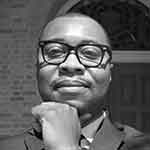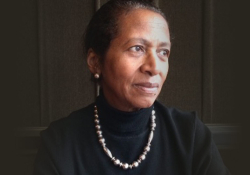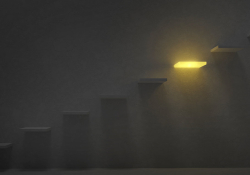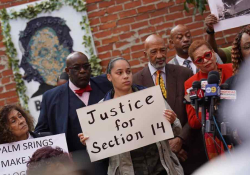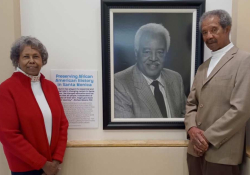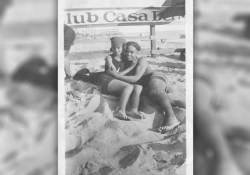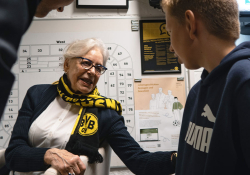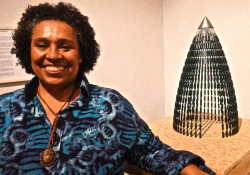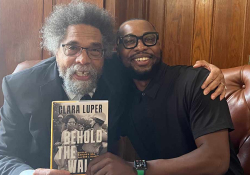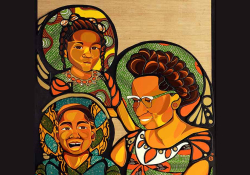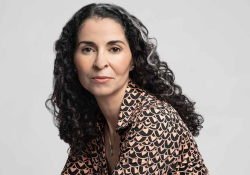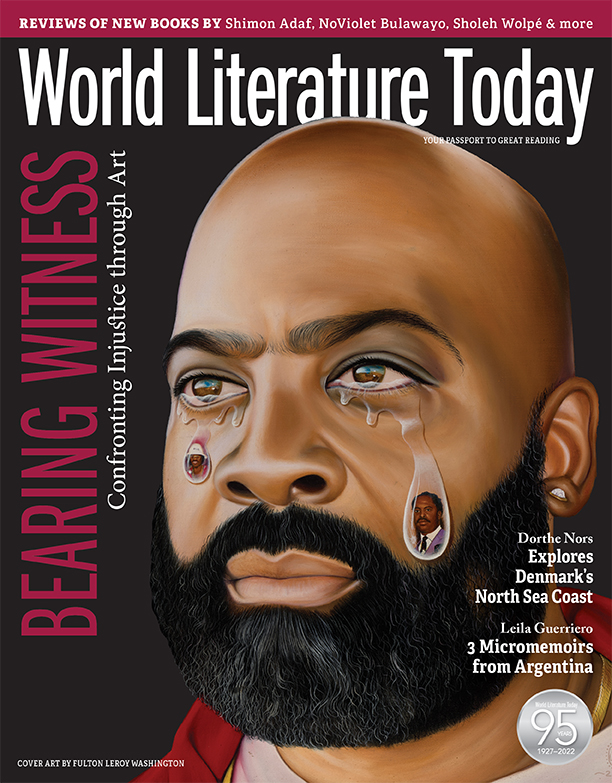In Compton, Telling a Visual Story of Struggle: A Conversation with Fulton Leroy Washington
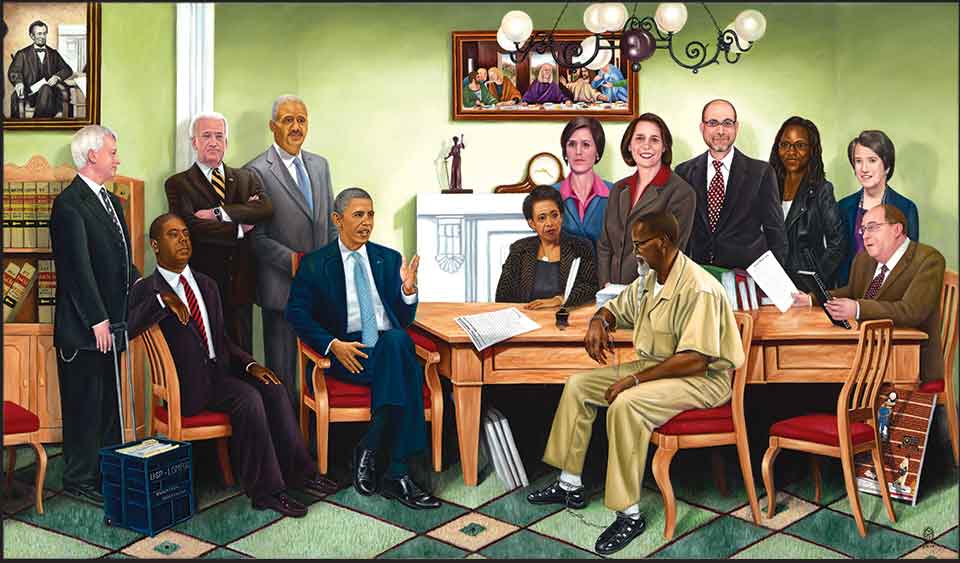
The story of how Fulton Leroy Washington became an internationally acclaimed artist is intertwined with the story of how he earned his freedom. Convicted in 1997 of a crime that he didn’t commit, then given a mandatory life sentence because of his prior arrests for a series of nonviolent drug offenses, Washington served more than twenty years in federal prison before being granted clemency by President Barack Obama in 2016. To this day, he maintains that his painting Emancipation Proclamation, which features President Obama signing an order to release him from prison, helped pave the way for the ultimate commutation of his sentence. Now a free man, Fulton Washington is electrifying the art world with his innovative approach to art, including, most recently, digital art. In July 2021 UCLA’s Hammer Museum awarded him the prestigious Mohn Public Recognition Award for his series of portraits of American presidents, celebrities, and former fellow inmates featuring oversized teardrops. In a recent interview, I asked Washington about the role of art in helping him gain his freedom and his hope for clearing his name, as well as his moving vision for building a community art center in Compton.
Karlos K. Hill: Your artwork is groundbreaking in so many ways. I’m thinking especially about your signature “teardrop” series, and the way the tears in the paintings often contain a story within a story. You are innovative not only in your artwork itself but also in terms of the conversation between your art and technology. On a deeper level, your artwork actually helped you secure your freedom. You leveraged your creative ability in a way that enabled you to gain the attention of the Obama administration, and from there, with the help of your lawyers and a number of intermediaries, you were able to walk out of prison a free man. Can you talk a bit about the ways in which art has helped you to liberate yourself? Not just literally, as in your liberation from prison, but also spiritually and emotionally. What was the significance of art in that process?
 Fulton Leroy Washington: Art became a way of communication for me in prison—a way to tell the story when I couldn’t find the words to say. It became a permanent record in history and time of what I was going through. It’s not so much that I was afraid of dying by incarceration, but there were so many other things in there that could take your life. And I don’t mean you’d be sitting in there for seventy or eighty years waiting to get old and die. I wanted to tell the next generation the story of the fight, the struggle, so that it would not be tainted with words that might create a different picture. So I was liberated by having that opportunity and the ability to capture that moment in time. I used the journey that I went through, through the criminal justice system and trying to prove my innocence and gain my freedom, to document as many aspects as I could of every court experience.
Fulton Leroy Washington: Art became a way of communication for me in prison—a way to tell the story when I couldn’t find the words to say. It became a permanent record in history and time of what I was going through. It’s not so much that I was afraid of dying by incarceration, but there were so many other things in there that could take your life. And I don’t mean you’d be sitting in there for seventy or eighty years waiting to get old and die. I wanted to tell the next generation the story of the fight, the struggle, so that it would not be tainted with words that might create a different picture. So I was liberated by having that opportunity and the ability to capture that moment in time. I used the journey that I went through, through the criminal justice system and trying to prove my innocence and gain my freedom, to document as many aspects as I could of every court experience.
I use art in that way to tell a visual story of a struggle. Many other people were living through the same thing, but those people had no avenue to communicate what was really going on. When the media come through the prison, everything tends to be sanitized, and everybody’s cautioned to be on their best behavior. Everyone’s cleaned up and dressed up, wearing decent clothes and trying to stay out of the way. That’s the sanitized version for the public, but it’s not the reality of what’s going on. So I use art to convey a little snippet of what life is really like in prison. When I go back in my mind to the memories, there are a thousand images that I can re-create to convey what it’s really like.
Hill: You have also been innovative in a technical sense. Can you talk about your latest work in digital art and NFTs (nonfungible tokens)?
Washington: This is a really new platform for me, because I didn’t spend a lot of time during my incarceration keeping up with technology. My main focus was trying to regain my freedom and prove my innocence. But coming home to this new world and being introduced to NFTs was like being given a blank canvas. I had an opportunity to go to OpenSea and look at their platform and see some of the things that people were creating in this new world. And I realized that NFTs offered a new opportunity, a whole new way to express myself—to take the artwork that I had already created and the images that are still embedded inside my soul and give them more life.
As an artist, I spend my time and my energy reaching into my subjects to bring out the human emotion. NFTs, especially the live ones that incorporate audio and animation, allow me to express myself on a deeper level. The first NFT I did was only the tip of the iceberg for me. Now I’m trying to learn the language so I can communicate with animators and programmers about expressing what I want to say. With physical paintings, I would need to produce four or five pictures to tell a single story, but with an NFT I can combine a much larger number of images into a series and break that down into segments of fifteen or twenty seconds. I’m able to make the art come alive right before your eyes.
I am honored that OpenSea; Corey Cooper, Anthony Kelani, from DNABLOCK; and their animator Diego Vazquez’s team are interested in working with me as an unknown person in this new industry, and grateful that they can look at my work and say, “Hey, what this guy is coming up with is different from anything we’ve ever seen. This is really amazing.” What they don’t know is that I’m just getting started.
Hill: You were able to use your artistic ability to secure your freedom. Do you think you will also be able to use it to help you clear your name?
Washington: That’s an interesting idea. I never looked at it from that angle. I’m going to give some thought to how I might seek out opportunities to use my artwork in that way. I spent the majority of my time in prison serving that community, teaching them how to do something different, showing them a new way to look at their situation, to take that time and turn it from a negative into a positive.
Going forward, I hope that I can share my art, and the talents that God blessed me with, with a bigger audience, both nationally and internationally. I want to share my perspective on how to observe and record history as it happens. By bringing my art to a social platform, I can help students from elementary school all the way to college. Sharing is like a seed: you plant that seed, and it enters into the heart and mind of a person, where it gets nurtured over time and produces fruit.
So, yes, I think the community-service work that I intend to do in the years to come, offering people another venue to get rid of some of the stresses, will bear fruit in a way that will help me prove my innocence. Maybe it will cause some of the people who wrongfully convicted me to take a second look and realize the mistake they made. Maybe they’ll be strong enough to stand up and say, “We were wrong. We convicted this man even though we had ample evidence that he was innocent.”

Maybe some of the people who wrongfully convicted me will take a second look and realize the mistake they made.
Hill: I would be interested to hear about your inspiration for building the Art by Wash Center in Compton, and how people who don’t live in in Los Angeles, or even in California, could support you in this endeavor.
Washington: That’s a complicated question. When I was young, public schools offered kids the opportunity to experience art in different forms, everything from playing with crayons in kindergarten, to learning color theories, to taking shop classes in junior high and high school. I guess they were trying to figure out who was gifted and who was not. I don’t see those opportunities being made available to children today, because our nation is all about commerce now. These days that’s the focus in school—training everyone to contribute to the capitalism that makes that money. Everything revolves around computers now, too, though, so the children don’t get the practical skill. They may get it in theory, but they don’t get it by actually doing it. I want to go back to giving kids those hands-on opportunities that expand their minds and imagination outside the boxes that society created, so they can learn to express themselves through some form of art.
By bringing that approach to the prison, I found that I could change the whole atmosphere there, including the violence. It gave them hope. When new inmates entered the prisons where I was housed, they’d say, “Hey, Mr. Wash, we saw you in the newspaper!” It showed them that regardless of what your situation is, you can be part of society from wherever you are. It doesn’t matter whether you’re in the dungeon or at the top of the castle, you’re still part of the same society, and you can make your contribution.
Now that I’m on the outside, I want to take what I’ve been blessed with and share it with the community I live in, and that community can then reach out to the neighboring communities, around the country, and even around the world. It’s not just me sharing, though; it’s everybody that comes there to be trained and taught, to gain some experience and insight. We share together, and they all get the opportunity to share back. So that was one of the reasons for my decision to settle here in Compton. It’s an area that’s really deprived, where opportunity, resources, and experience are really scattered. I’m working in a senior citizens’ apartment because we don’t have a community space that embraces people with an interest in art.
And yet art is a big part of our world: everything that we see and do, from the homes we live in to the stores we shop in, it all starts off with an idea in someone’s mind, and that idea turns into a physical piece of art, and then turns into a physical building, advertisement, or product. So there’s this analytical step—from idea conception to service to the community—that people are missing. Everybody wants to click a button and produce a magnificent piece of art or product, but it doesn’t happen like that. There are steps that you have to go through to build that image up, to bring it to life.
It doesn’t matter whether you’re in the dungeon or at the top of the castle, you’re still part of the same society, and you can make your contribution.
So, that’s what I want to do here. I want to plant a seed here in Compton, and pray that God will bless the community to accept it, that they will nourish it and water it and let it keep growing.
Hill: I can see through your Art by Wash website, through your community service, and through the power of your art and the message in your art that you have a very clear vision for the kind of impact that you want to have. And it starts with clearing your name—not just for you personally, but for your family and for your legacy. My profound hope is that these things will eventually come together in such a way that the State of California will do what should have been done years ago. Having come to know your story, I’m convinced that it isn’t finished yet.
June 2022
This is the first installment of Bearing Witness, appearing every other issue, wherein Karlos K. Hill highlights the efforts of cultural figures doing works of essential good around social justice issues.
